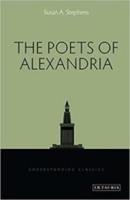
IB Tauris (2018) p/b 208pp £12.99 (ISBN 9781848858800)
This study appears in a useful series (‘Understanding Classics’) edited by Richard Stoneman; mainly about individual authors, which makes this an apparent exception, for it is clear that S. thinks her four poets can best be understood in the political and social context of the city at the centre of Hellenistic literature.
Hence her lengthy introduction (‘Changing Places’) about Alexandria, a city in transition: ethnically mixed though predominantly Greek-speaking, whose poets were at once aware of their literary heritage but also ready to innovate and experiment, and always alive to the far-reaching influence of its kings. The Ptolemies were ‘in the process of inventing their monarchy; they ruled a Greek-speaking population as if they were the inheritors of the legacy of Alexander, but … their Egyptian subjects as if they were pharaohs’.
S. works carefully through the creation of a new poetic language, perhaps reflecting the regional versions of Greek spoken by inhabitants, and the city’s physical space, especially the Library, vigorously encouraged by the Ptolemies as the Greek diaspora’s intellectual centre and focus of scholarly inquiry. Then we are into the bulk of the book: four chapters devoted to Posidippus of Pella, Theocritus, Callimachus, and Apollonius of Rhodes.
The publication in 2001 of a papyrus roll of 122 epigrams by Posidippus, totalling nearly 500 lines, and, according to S., possibly arranged by the author into a poetry book, led inevitably to a scholarly reappraisal of Hellenistic poetry. Some poems are on familiar topics, some not: for example, victories in horse-racing, augury, and statue-making. S. makes a case for these short pieces making up an interlocked broader narrative. One sequence celebrates the rhythm of women’s lives (household, marriage, children, mourning relatives, introduction to the mysteries), contrasted with men’s lives, which take them away from home as soldiers, businessmen, competitors in the games. They often die abroad, while women stay at home and anchor the family. The Ptolemies made much of their Macedonian origins; the papyrus roll seems to have been in use for fifty years, and then recycled as part of a mummy’s wrapping, which for S. neatly illustrates the distinctive cultural blend of the new Alexandria.
Commentators on Theocritus have often been puzzled by the diversity of his output; what have bucolic poems to do with encomia of contemporary kings, epyllia on mythological themes, and urban mimes? S. argues for a coherent poetical outlook. She discerns an almost Virgilian political undertone in some of the pastoral poems, and ‘a consistent pattern of myth, allusion and intertext that is not limited by genre or poetic type and that constructs the ruler and the pastoral landscape as mutually interdependent’. Cos is the ideal land, ‘in which poets can flourish and in turn celebrate (and thus nurture) the king’. More speculative is her portrayal of Polyphemus as a conspicuous consumer, disturbing the locus amoenus and therefore the healthy balance of rulers and ruled.
S. does not swallow the traditional construct of Callimacheanism: ‘small is good, elegant, polished, and learned is even better’. Callimachus’ Aetia, for example, ran to nearly 6,000 lines. The error arises from the ‘practice of … unconsciously filtering him through the experience of Classical Athens and/or later Roman poetry’, and possibly from the fact that much of his output exists in fragments. Her account of this important poet is generally balanced and just. She notes his sure handling of sources and genres (she has edited the Hymns, which she thinks may have been performed), and interestingly suggests that his varied narrative voices help him to express a variety of cultural practices, again reflecting the experience of living in Alexandria.
As to Apollonius, says S., his choice of the epic form of course shadows Homer, but his hero can no longer project heroic values and the ethos of what was later to become the ideal citizen soldier. The old Panhellenic model was now ‘fraying at the edges’; third century Greeks fought not for their poleis but as mercenaries, and kinship with Alexander meant more than descent from Achilles. The Argonauts’ adventures took them away from the Iliadic world to places familiar to citizens of Egypt (see, for example, the lengthy Libyan episode). In a bold move, says S., Apollonius borrows Homeric energy to inject life into Alexandria’s invention of itself as a cosmopolitan, immigrant city.
This book is intended primarily as an introduction for undergraduates, but can be read with profit by more advanced students, and indeed by generalists interested in the classical world. All Greek is translated, and the narrative is uninterrupted by scholarly technicalities—though there are 25 pages of bibliography and notes. In this, S.’s account is a worthy companion to Stoneman’s Pindar. Not everyone will go all the way with the influence on its poets of Alexandria the mongrel city, but her happy combination of scholarship and clarity of expression is an ideal introduction for anyone wanting to find out and think about Hellenistic poetry. The chapter on Posidippus is alone worth the book’s modest price.
Anthony Verity
